Dutch soldiers called it ‘God’s justice’, shooting the loser of forced fights between Indonesians*
* In the original Dutch publication the editors of Trouw used the term “Indiërs” in the heading, which is confusing because in Dutch language “Indiërs” is commonly used for people from India.
Trouw, January 25, 2018, Text: Tineke Bennema and Yvonne Rieger-Rompas, Translation by Annemarie Toebosch
Senior Dutch soldiers organized hand-to-hand combat between those suspected of resistance in the former Dutch Indies during the Indonesian Independence War of 1945-1949. Whoever lost got the bullet.
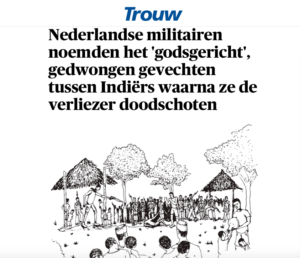
He who won was promised mercy. Whoever lost got the bullet. Eleven relatives, from three villages in South Sulawesi where the fighting took place, are now filing a case against the Dutch state.
The single combats were already mentioned in a report that the lawyers C. van Rij and W. Stam drafted on behalf of the government about atrocities in South Sulawesi. This 1954 report disappeared into a drawer, as did the 1969 Memorandum of Excesses. As a result, the forced hand-to-hand combat has not previously received wide attention.
Now researchers Tineke Bennema and Yvonne Rieger-Rompas have mapped four cases, and they also found relatives and witnesses in Indonesia.
In addition to the four cases mentioned, Van Rij en Stam’s report mentions two other fights, bringing the total number to at least six. At the time, Dutch soldiers called the duels ‘God’s judgment’ or ‘God’s justice’.
Van Rij and Stam’s report names two senior soldiers who were responsible for the fights: the infamous Colonel Raymond Westerling and Captain Berthold Eduard Rijborz. Rijborz received a high military decoration in 1947 for bravery.
The eleven relatives now want to bring the case to court because of the hand-to-hand combat and the violence and mass executions surrounding it. They are represented by lawyer Liesbeth Zegveld. She will write a letter to the state in which she raises the matter. If the state pushes the affair aside and does not want to accommodate the next of kin, a lawsuit will follow, as has always happened in the past when next of kin brought such cases.
Fight for your life
One of the eleven relatives to bring the case is 80-year-old Ambo Asse, who still lives in the mountain village of Lisu surrounded by forest and rice fields. He is tall, toothless, with a keen eye behind black glasses.
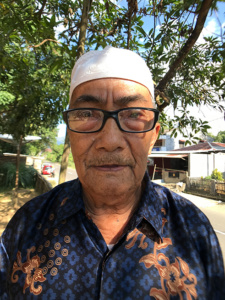
It is etched in his memory: on February 7, 1947, as a ten-year-old, he witnessed hand-to-hand combat and mass murder in the village.
He is controlled when he tells his story. All inhabitants of the village were herded together on the market early in the morning by Dutch soldiers of the Royal Netherlands East Indies Army, or KNIL, led by ‘a man with a red scarf and without a cap’.
Asse: “The soldiers asked who was in charge, and this person had to then identify who was involved in the uprising. Iabu, a thin man, was pointed out by Beddu Tjolle, who was a lot taller than him. But Iabu protested and denied that he was part of the rebellion.”
With no apparent culprit, the commander ordered the men to fight each other.
In 1954, lawyers Van Rij and Stam presented a report on wrongdoings in South Sulawesi. The report commissioned by the Dutch government shows that it concerns the infamous Colonel Raymond Westerling. Although he denies in the report that the single combat happened on his initiative. During his questioning he does say that he acted there as ‘Public Prosecutor, judge and executioner’.
“Beddu Tjolle won of course”, Asse continues. “Iabu lay on the ground and was shot. Some of the assembled men had fled. The soldiers pointed out seven men to find them. They were promised they would not be shot. In the end, they were shot anyway. I was a child, I saw the executions, but I did not understand any of it. We saw Dutch soldiers of a regular basis, they even came fishing. This happened suddenly. My father managed to flee, but he is still missing. The bodies were collected by the families and that lasted into the evening.”
There is a monument with 47 names at the site of the mass murder now. Iabu is number 16. The lawyers who wrote the report call the single combat “a mental torment.”
The cleansing by KNIL and the Depot Special Troops (DST) was the backdrop for the hand-to-hand combat. Later it would be called the ‘South Celebes’ affair. The cleansing by Westerling and his men has been revealed little by little in recent years, but these single combats, well known in small circles, were never widely publicized until now.
Lieutenant Governor General Huib van Mook declared ‘the state of war’ on South Sulawesi in December 1946 because of fierce resistance from Indonesian nationalist troops to the Dutch invasion of Indonesia, which had declared its independence. Westerling was recruited as head of the special commandos.
The Westerling Method
Westerling, with the tacit approval of the Dutch local military, legal and civil authorities, developed the so-called ‘Westerling method’: driving the local population to a central point, such as a market; searching for weapons and suspects, with summary executions if found; giving a speech, after which the population themselves had to point out insurgents among them who were then executed.
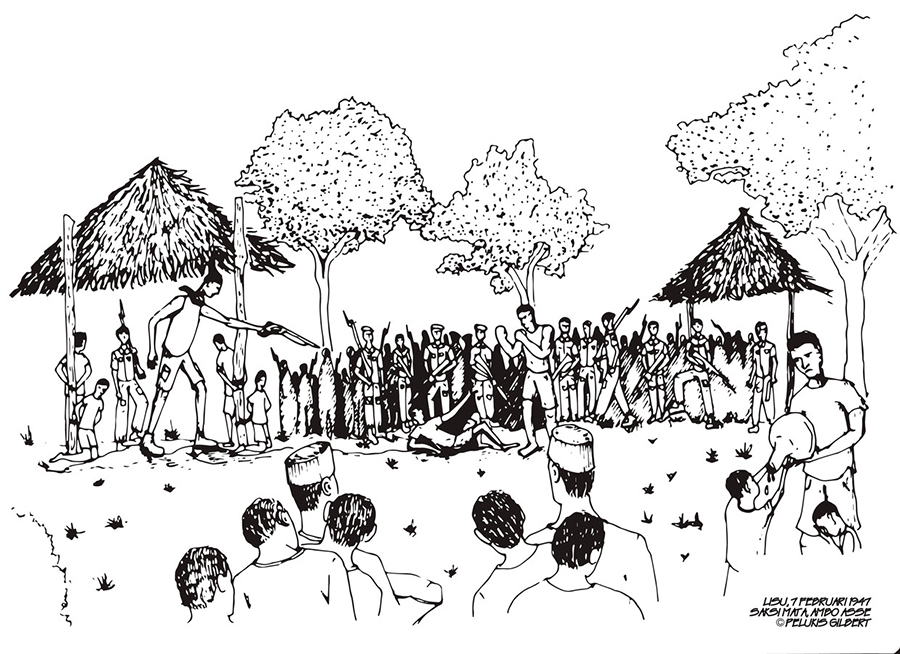
Westerling received the euphemistically termed ’emergency jurisdiction’ from the joint authorities, a license for summary executions. Despite reports of massacres that Westerling carried out in December, the authorities in Batavia extended this emergency jurisdiction on January 6, 1947. They found that the Westerner method paid off. KNIL captain Berthold Eduard Rijborz was assigned this authority as well, as were his superiors, KNIL msjor Jan Stufkens and DST captain Jan Vermeulen.
In the first phase of the so-called pacification and cleansing, until early January 1947, Dutch soldiers still searched for insurgents using lists of names, but afterwards they arrested people that were pointed out by the population. According to historian Rémy Limpach, Rijborz and Stufkens would have killed 700 innocent people in a mere two weeks.
In the second phase, arbitrariness based on such selections increased: a word, an argument, a feud among themselves was enough for a bullet by Dutch soldiers. The mutual accusations sparked quarrels between innocent men. The soldiers did not intervene and had the pointer and pointee fight each other. God would show who was right in the end.
Van Rij and Stam hold Colonel Westerling, the man who started the man-to-man fights, responsible for ‘a few’ duels. Westerling admits that there was such a fight (place and date unknown) between men who had robbed and tortured others to death. He told the population that he wanted to make these “people feel what they had done to their victims.” He states that both were later killed. Such fights also took place under Stufkens’ command, the lawyers say.
Van Rij and Stam believe that Rijborz was ultimately responsible for duels in Koelo and Amparita, two other places where man to man fights were held, according to both their report and the Memorandum of Excesses published in 1969. ‘Even if this captain had not given the command for it, he still bears the responsibility for not intervening.’ Single combat took place during mass murders in both places. 83 people were summarily executed in Koelo on February 9, 1947, and 55 victims were killed in Amparita on March 3. This happened under the command of Rijborz, who himself, incidentally, denied having held any single combat.
Sadistic
According to the report, Rijborz was commissioned by Stufkens on February 5, 1947 to ‘cleanse’ the Sidenreng-Rappang region. Rijborz was born in Surakarta and entered military service in 1921. At age 33, Court Martial sentenced him to six weeks in prison for inciting manslaughter. During the Japanese occupation he was in camps, a prisoner of war in Singapore among other places, and forced to work on the Burma railway. Rijborz’s men thought he was’ unpleasant’, and he was feared. One supervisor determines that the captain is suffering from depression, obsessions and suicidal thoughts. He was also said to have a sadistic mentality, as the lawyers note in their report.
Rijborz did not agree with what he thought was the ‘normal’ KNIL lack of freedom to maneuver as compared with the special powers of the DST. He had set his sights on the emergency law ordinance, the unchecked power that he eventually received from the highest military authority.
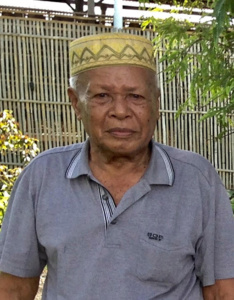
Some fights were short. In the report, Lieutenant Johan Molenkamp testifies that in Koelo, identification of victims by the population takes place under the leadership of Rijborz, and that he saw ‘two Indonesians fighting in this action’. He later learned that this was a type of divine judgment. The whole thing struck him as messy. It was much less ‘messy’ elsewhere: in Amparita there is an organized fight, with set rounds, breaks and spectators.
Amparita, more than a hundred kilometers from Lisu, is a larger village. There is now a mosque on the site of the fights. The 89-year-old La Mude Benga, who, like Ambo Asse, wears a kopiah, an Islamic cap, witnessed the fight: “Dutch soldiers drove into the village in an open military vehicle at four in the morning. In it were three Dutchmen. There was a policeman from here, his name was La Kille. They were shouting that we should all come down (the houses are on stilts) and sit on the pasar in a U-shape.”
Five rounds
The report by Van Rij en Stam confirms that Indonesians start pointing out people on Rijborz’ orders. Executions follow on the spot, in front of the people of the kampong. An argument break out when a man points out another who says he does not belong with the rebellion. A witness in the report: ‘Next, the captain (Rijborz) called the wakil (village leader) and La Kadetjing aside, and told them to fight. He who won was right and whoever lost would be shot. All the soldiers stopped firing and gathered around to see it. Every time they got tired, the soldiers separated them, and they had to start again later. They fought about five rounds, like a boxing match. When the wakil was wounded from his mouth and fell to the ground, he was shot by the captain.” La Kadetjing is Mude Benga’s uncle. “He was a big man and was allowed to sit back down.” La Mude’s story too sounds business-like.
Decoration
Rijborz was awarded the Bronze Lion on August 4, 1947 through a decision by the Distinctions Committee in Batavia, because he showed himself to be a ‘fearless leader’ and he ‘distinguished himself by performing exceptionally courageous and discreet deeds’. The nomination takes place on the initiative of Stufkens. There is no mention of his imprisonment anywhere in his file. General Spoor does, however, still write in pencil in the margin still: “Hold this nomination, since a case is pending against Rijborz in connection with his actions, currently under consideration.”
Shortly before that, Spoor had set up the Enthoven Commission, charged with investigating the truth of reports of atrocities in South Sulawesi. Nevertheless, the Commission does not await the outcome of the report, which was presented in 1948. The army commander must have overcome his objections in three days’ time, and gave his final approval for the decoration.
Van Rij and Stam state in their report that the government wrongly granted the emergency powers, which is a violation of the law of war. But it never came to criminal prosecution. Their findings disappeared in a drawer, as did the Enthoven report and the Memorandum of Excesses of 1969. Parliament stated that the crimes had passed the statute of limitations. Rijborz returned to the Netherlands and died in Sliedrecht in 1974.
Both victims
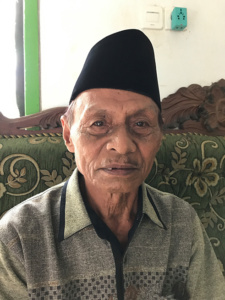
Iabu’s son, Santa (70), is five months old when his father is killed in single combat in Lisu, and he has heard the story from his mother. He is emotional when he tells us that his father worked as a foreman in making roads and lost the duel because he was small. “My mother took his body and he was buried along with five other men, including my uncle. My grandmother helped us. I couldn’t go to school because there was no money. I became a farm laborer. Later my mother remarried. Still there was no hatred between the Iabu and Beddu Tjolle families: they were both victims.”
La Mude Benga from Amparita: “The people were terribly afraid. When the Dutch drove away, those who survived the massacre recovered the bodies: fifty were killed. It rained that day and blood was streaming.”
The people affected, together with other villagers from Lisu and Amparita, have announced that they will bring the case to the state because for their suffering. They are represented by Dutch Honor Debt Committee K.U.K.B. and lawyer Liesbeth Zegveld.
—
Tineke Bennema is a historian and Yvonne Rieger-Rompas is a researcher in Indonesia.
